STUDENT INITIATIVES
Students are an integral part of the work Health in Slums does in Bangalore. Students from Maastricht University and Zuyd University of Applied Sciences have contributed, and continue to contribute, to the work of Health in Slums in numerous ways, working on our core projects, as well as on projects implemented by our partners, in order to contribute to the efforts of the Health in Slums network in Bangalore overall.
WORK ON OUR CORE PROJECTS
Overall, five Masters in Global Health students have contributed to the work of Health in Slums thus far, conducting research on a range of topics relating to our core projects – Project Exhale and THULSI – as well as other relevant topics. Two of these students – Cristian and Preeti – have stayed on to build on their initial research as PhD students working on Project Exhale.
In addition, students from other programmes at Maastricht University – including International Medicine – have worked, and continue to work, with our PhD students on Project Exhale.
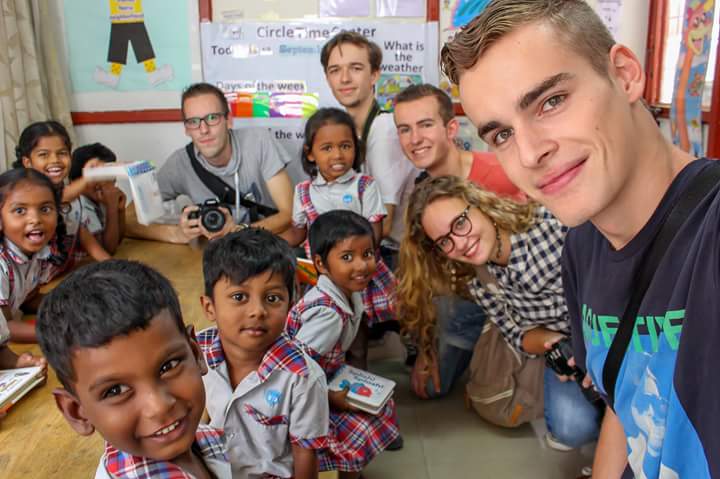
Max and Nienke worked on the THULSI project during the field testing of the first prototype of the toolkit
When we arrived in Bangalore at the beginning of May, it didn’t take long before we noticed some of the huge gaps between the different layers of society in this rapidly developing Indian city. Huge skyscrapers and bridges are under construction, while the slum areas are continuing to expand rapidly. One of these slum areas is Devara Jeevannahalli (known informally as DJ Halli), where Bangalore Baptist Hospital (BBH), together with its partners, is committed to providing health care to one of the poorest and most vulnerable sub-populations within the city.
Although major advances have been made in improving certain health-related aspects including sanitation, awareness and local infrastructure, within the area of DJ Halli, it is still a symbol of poverty within Bangalore. With a field clinic already in place in the area, the hospital is currently aiming to improve screening and diagnostic services through the introduction of a diagnostic toolkit developed as part of a Health in Slums initiative in close collaboration with the University of Sheffield, Zuyd University of Applied Sciences, e-Health Enablers and ICARUS Nova. The initial prototype of this toolkit – Kit 0 – is currently being field tested through a pilot study, during which it will be evaluated and refined. As part of our thesis research, we, as Global Health students, are aiming to gain insight into the problems and efficacy of the toolkit, based on which recommendations for further development and improvement can be made.
BBH cooperated with its partners to send teams of nursing students into DJ Halli, to use and test the toolkit as part of this field trial. Five teams (consisting of 5-6 nurses) visited approximately 120 households per day and provided free health check-ups to anyone willing to participate. In practice, this means all participants got a height and weight check, while girls over 12 years of age received haemoglobin testing, and those over 30 years of age received blood sugar and blood pressure testing. All data is processed using a corresponding mobile application – THULSI – named after the project, Toolkit for Health Urban Living in Slums Initiative.
As of mid-May, a total of 3694 people belonging to 1187 households have received health check-ups in this way, providing insight into the basic health status of the inhabitants of DJ Halli, as well as the health needs of the local community.
It is really impressive to see the extent to which small teams, with limited equipment are able to obtain a snapshot of the health status of the community, mobilize people to look after their own health, and motivate them to follow-up on the house visit at a later date by going to the field clinic. As Bangalore continues to grow, so must the provision of healthcare within the city. Based on our experiences thus far, we see that the use of mobile and electronic tools, such as the THULSI toolkit, have great potential in terms of enhancing the health for all slum inhabitants.
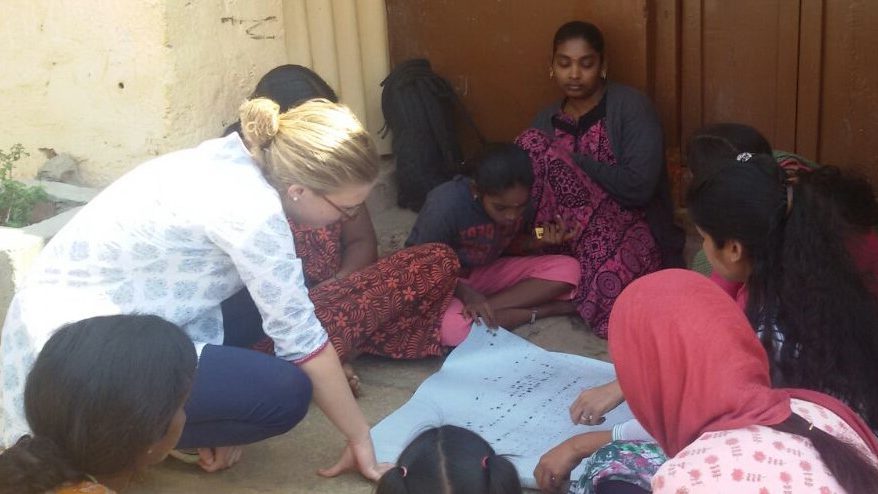
Esther worked with our PhD student Dr. Megha Thakur to suppport her in her research
My name is Esther Boudewijns and I am living in Bangalore for 4.5 months to help with the research regarding improved cookstoves in slums. I am working together with Megha Thakur and we are conducting a randomized controlled trial, whereby we follow-up with 250 households. Half of these households will get the improved cookstove and the other half will continue using traditional stoves. In the last few months, we have mainly focussed on the preparations for the randomized controlled trial, including mapping of the slum area (which is not as simple as it sounds), organizing community meetings to inform the people about the research, developing measurement devices and questionnaires, thinking about the best study design and testing the new stove. In the coming months, we hope to start with the recruitment of the participants and the baseline-measurements. The work here is very diverse; we meet a lot of different people and visit a lot of places, including slums, hospitals and research institutes. It is nice to see the relationship we have built up with the people in the slum and how their trust in us has grown during the past few months. Besides the work for the project, we also try to take care of other health needs of the people living in the slum. For example, Narasamma – a 65 year old woman from the slums – had some vision problems. We took her to the hospital and helped her with the preparations for a cataract surgery. Even though there will be still a lot of work to do when I leave, I am glad that I could have contributed to this beautiful project.
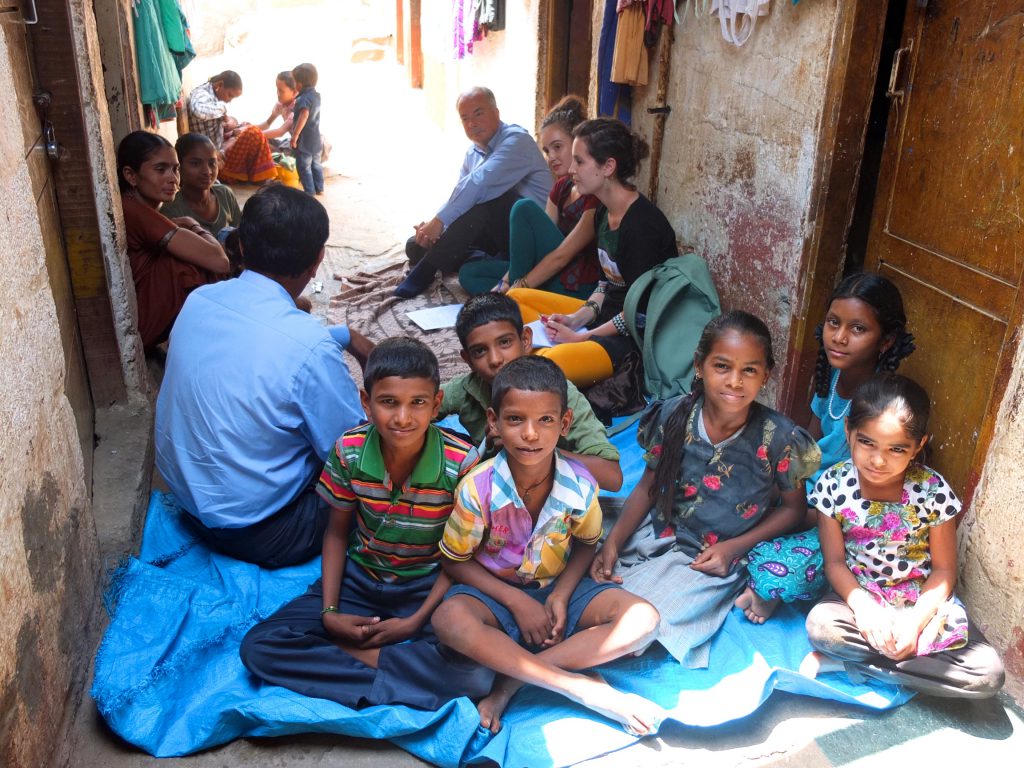
Paulien explored the topic of air pollution and respiratory health in research contributing to project EXHALE
A year and a half ago I was introduced to Project EXHALE to conduct research as a master student. Since, I have written a systematic review on the impact of improved stoves on indoor air pollution and health, and several months ago I conducted fieldwork in the slums of Bangalore. One of the goals of ‘Health in Slums’ is to improve the health of slum-dwellers. An important aspect of this is an initial assessment of conditions, and the health of communities, within slums. Such information can help to gauge whether improved stoves developed through Project EXHALE can facilitate improved health.
Together with my research partners Kim Kul and Judith Sprunken, and our local partners, I conducted interviews with slum communities about their health, to try and identify the types of respiratory symptoms, if any, men, women, and children are experiencing. Interviews took place in three different slums, with the help of a local translator. In addition to interviewing families, I also measured indoor air pollution in a select number of households to get an idea of the levels of pollution people are exposed to on a daily basis.
I found that ‘warning symptoms’ such as fever and cold-related symptoms were most common. However, no specific respiratory related symptoms or conditions could be identified. This does not necessarily mean that slum-dwellers are not suffering from respiratory-related diseases. These results merely highlight the fact that perceptions and knowledge of health may be very different in different settings. People in high-income countries generally know what it feels like to be healthy within their own context, but slum-dwellers living in India have different perceptions and standards with regard to their health. They grow up in a resource-poor environment, and may continuously have a cough, headache, or experience shortness of breath. However, they may not feel that this is a so-called ‘sick’ state, because this is what they feel on a daily basis. In addition, knowledge of health and priorities in life may also be different.
When can you really say someone is in good health? From what perspective should we view such health issues? These are essential questions that we must take into account when assessing health. The next steps of Project EXHALE aim to conduct a quantitative assessment of respiratory health, which will provide a more objective measure of health.
Overall, conducting fieldwork in the slums of Bangalore was an adventure, and it was an absolute honour to work so closely with the slum families.
Charlotte and Sarah explored contextual factors relating to maternal and reproductive health in urban slums in Bangalore
Our thesis research was based off the assumption that improvements in preventive and healthcare-seeking behaviors to improve women’s sexual and reproductive health, depend on the knowledge, attitudes, and values of women and communities. In the two months we were in Bangalore, we set out to investigate the reasons behind women’s poor maternal health and the under-utilization of reproductive and maternal healthcare services in three slums, where contraceptive usage is reportedly very low and maternal mortality is very high. The research project was based on extensive Indian–Dutch collaboration, between Maastricht University, Zuyd University of Applied Sciences and Bangalore Baptist Hospital. The latter also acted as the host institution for the data collection during our stay. The data were collected doing qualitative research, whereby interviews were conducted in order to understand how perceptions and beliefs affected maternal and reproductive health, and access to relevant health services. The nature of the research meant that several hours or days were often spent with the same participants.
Additionally, the nature of this type of study made the process of the data collection a rounded experience, rather than a straight forward quantitative process that we had experienced before. While being foreigners introduced in these close-knit communities wasn’t always easy, we were lucky enough to get to know the women that took part in our study well. Many of the women openly and warmly invited us in their homes, allowing us to get a sense of their lives. One aspect that struck us the most was the diversity we saw in the slums; not just between the slum communities, but also between the people living there. In just the three slums that we studied, there were several languages spoken, different religions, cultures and practices. Whilst some the people that lived in these slums had travelled from all over India and had only recently settled in Bangalore, others had lived in their communities their whole lives. In essence, the diversity both between and within the slums combined with the qualitative approach, allowed us to gather variance in the data on beliefs, practices and perceptions and culture in the context of women’s sexual and reproductive health. Based on our experiences and results, we therefore suggest that interventions that aim to improve inhabitants’ health, take into account these diversities. Finally, the strong impact culture and beliefs play in these communities’ health was highly valuable, and offered us a different lens on how other cultures can perceive their health. As some of these practices and beliefs were not necessarily wrong, it does indicate that interventions would have to work with them, rather than go against them.
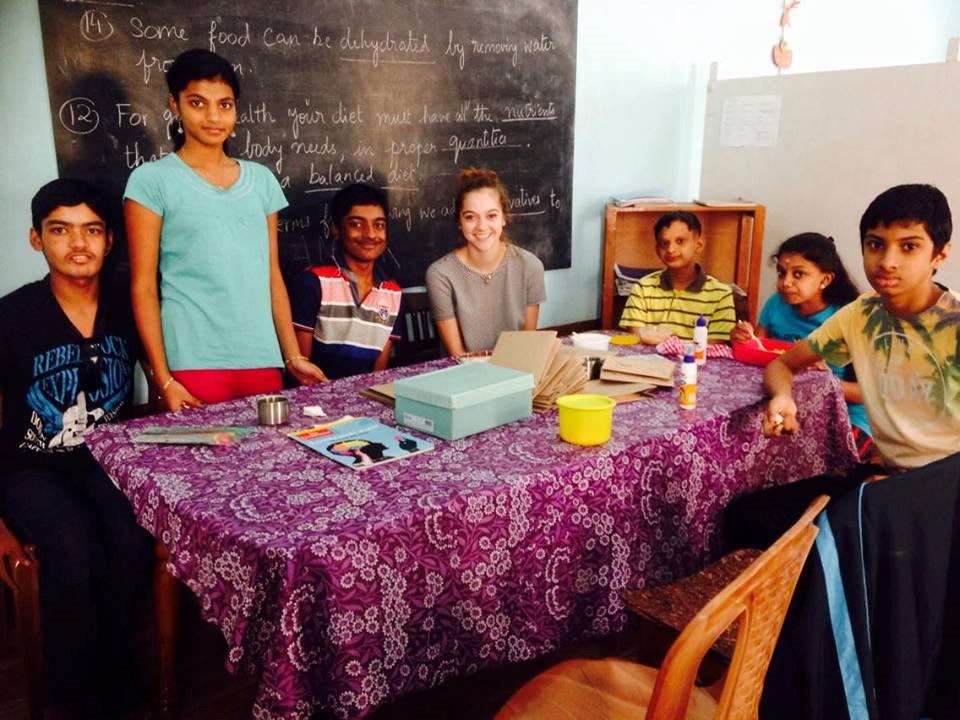
Aniek (Hotel Management), Thom (Hotel Management) and Joyce (Dance Therapy) worked with One Good Step at Vimarsha, with students with a range of physical and learning challenges. Aniek and Thom (who took over from Aniek) helped them to develop a baked product (cookies) that they could sell, and helped them gain a range of related skills, while Joyce helped them with dance/movement therapy.
WORK WITH PARTNER ORGANIZATIONS
Since 2015, over 35 students have participated in Health in Slums Exchanges – a parallel and contributing programme to Health in Slums – at Zuyd University of Applied Sciences. Many more students are expected to participate in this programme in the future.
These students have come from range of different study programmes and have contributed directly and indirectly to the health and well-being of slum communities (and other vulnerable communities) by working with our network of partners in Bangalore.
Study programmes represented thus far include: Hotel Management, Built Environment, Social Work, Design, Communications and Multimedia Design, Nursing, Midwifery, Physical Therapy, Occupational Therapy, Dance Therapy, OTC (Translation and Interpretation), Facility Management, HJO (Higher Legal Education), People and Business and European Studies.
35+ students
15 partner organizations
15 different studies

Esther and Romy (OTC) worked with one of the GAP Changemakers – Building Blocks – at a school that helps to provide support to children who have not had formal schooling but hope to enter the formal school system by equipping them with the skills needed for this transition.
Stan (build environment), who worked with SELCO Foundation on developing housing for urban migrants
Imagine yourself, you live in India inside a slum. You are living in a house that has been built by the materials you were able to find. There is no such thing as ventilation and daylight inside. The food is prepared inside, which causes a lot of smoke and an unhealthy indoor environment. You don’t have access to drinking water, a decent toilet, electricity, healthcare and so on. Every day you need to find some work to make sure you can afford food for your family. Your future is insecure.
My name is Stan van de Schoor, I am a 4th year Built Environment student at Zuyd University Heerlen. I chose to go abroad for my pre professional internship. Via Health in Slums Exchanges (a parallel and contributing programme to Health in Slums) I got in touch with one of its partner organizations – Selco Foundation, a NGO in the city of Bangalore. Here I lived from February until July.
Selco India focusses on providing people in slums with electricity, mostly via solar panels. Selco Foundation is a part of Selco India. Selco Foundation focusses on improving life in the slums through new technologies, products and innovations. Within Selco Foundation I worked together with an architect, solving Built Environment-related issues.
Throughout the entire internship I was busy designing houses for the people in the slums. We were trying to design some kind of house that would be affordable for everyone. The house needs to have ventilation and daylight. It also needs to be collapsible and dismountable, in case of ejection of the slum community.
During my time in India I made several prototypes of our HUM (Housing for Urban Migrants). We built these HUMs inside the slums so that a family could live in it. We gained a lot of knowledge with each prototype we made. Just before I left India I finished my last prototype, which was completely my design.
I am glad that I chose to go abroad. For me, this internship has been the best experience in my life and I have learned so many new things on social, cultural and professional level.
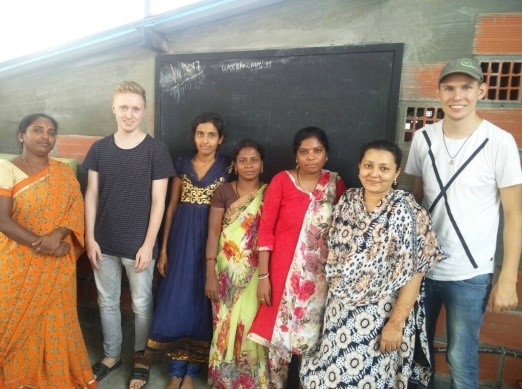
Tim and Ralf (Occupational Therapy),worked with MAYA (Movement for Alternatives and Youth Awareness) to incorporate Occupational Therapy considerations and practices into the work of their Health Navigators in a way that fits the local context.
Jeroen, Joeri, Bob, Meggie and Jordy (communications and multimedia design) helped us to develop a website
They helped us develop our new website and worked with global action on poverty to create videos showcasing the work of a number of their changemakers.
Samana (Nursing) worked with the Community Health Department of Bangalore Baptist hospital for her internship
I am Samana Rikers (25), a Zuyd University of Applied Sciences final year nursing student from Maastricht and I always had the ambition to work abroad in the field of health care, particularly in low-resource settings.
However, when I heard about the possibility of an internship in India initially, I was also a little scared. I knew I had to go there, but I was afraid that I would not be able to deal with the big contrasts – including between the rich and the poor – in the country. Nevertheless, it turned out to be the best experience of my life.
My internship was 12 weeks in total – 6 weeks within different wards at Bangalore Baptist Hospital (BBH) – a partner within the Health in Slums Alliance – and 6 weeks in its Community Health Department (CHD). In the wards, I was able to observe and join many procedures that I have never had an opportunity to see before in the Netherlands. However, it was through the CHD that I really learned the most, particularly about India and its culture. The mission of the CHD is to make a difference in the lives of the poor living in the rural and urban areas of Bangalore. In the rural areas, situated up to 1.5 hours drive away, I got the opportunity to accompany the team in a “clinic on wheels”, which visited several different villages around Bangalore. This is how the CHD reaches about 900 villages to conduct health screening and provide medication, as needed. In addition, there are planned home visits for palliative care patients and several other programmes such as the alcohol de-addiction and rehabilitation programmes. Further, in one of the slum districts, there is an Urban Health Centre, which provides primary care to the poor and marginalized groups.
For my assignment, I worked in the slums of Bangalore, where I sought to raise awareness about the dengue virus, which is transmitted by mosquitos, because many people in slums don’t know it can be a fatal, but preventable disease. Together with a doctor, health educator and a volunteer, I organized several classes and presentations on the streets, in small houses or in schools in the slums to raise awareness. If you actually want to make a difference, it is essential to involve, and work together with, the local people in finding solutions for problems such as dengue.
Before I first visited the slums, I expected the situation there to be horrible and hopeless based on what I had heard. When I visited the slums, I did see very challenging circumstances. However, when I walked in there, I actually felt happy. To see all these colorful houses, the sweet faces of women who take care of each other, their many children and the grandmothers within the community, and their efforts to make the best of the situation. It seems to be such a contradiction – to see all these women and children smiling but behind almost every smile a horrible story is hidden.
In the Netherlands, most people have insurance and a complete household with furniture, but are still unsatisfied with what they have and keep collecting more. Having experienced what I did during my placement, I felt a little guilty of this, but also motivated to do something about it.
When I arrived back from the Netherlands I was sure: I will work in the field of health care in low-resource settings once I have graduated. Now I know better what I want, where I stand and who I am. I’m very grateful to BBH and inspired by all of its great nurses and doctors who work so hard to make a difference in the lives of slum communities in Bangalore.
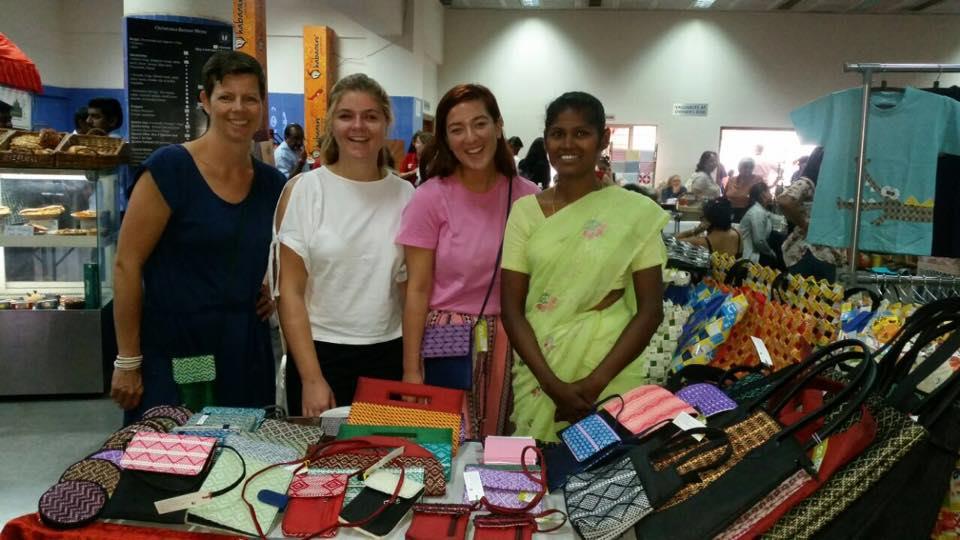
Naomi and Frederique (OTC and Hotel Management) worked with ANULife – a project where women from slum communities recycle discarded juice cartons, cement bags and other materials to create products, such as bags – to support them with their promotion and marketing.
